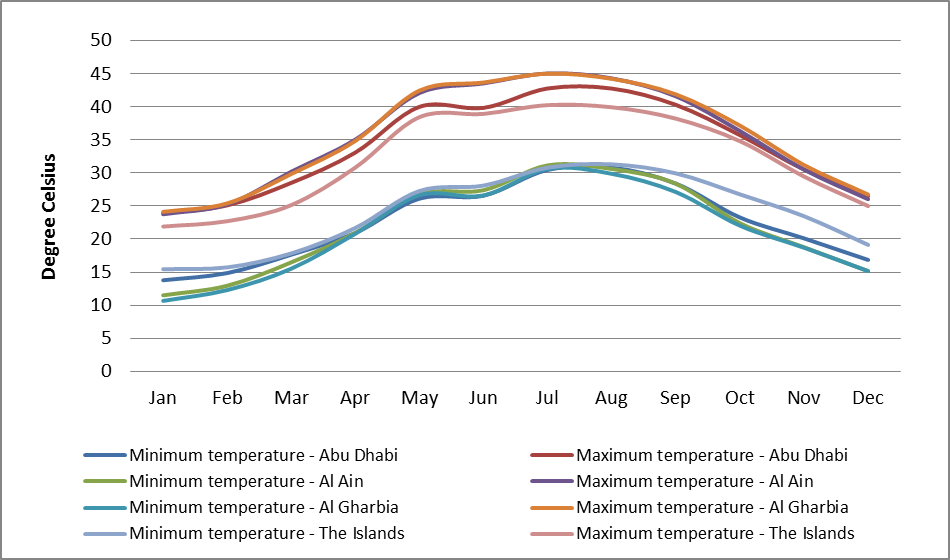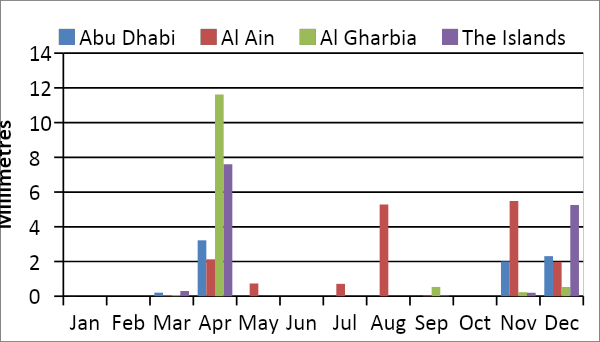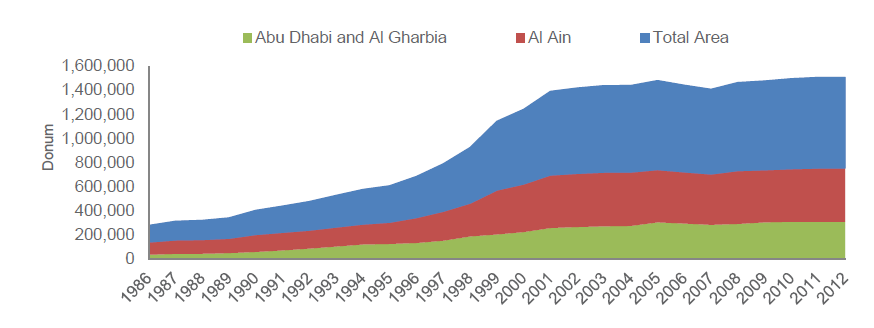Problem definition
Agriculture is an essential aspect of human survival in the world, as it is a source of food and income. In the UAE, agriculture is highly recognized as part of people’s culture. It is obvious that farming needs a lot of labor, energy, land, and water. Most of these requirements are in short supply in the UAE; for instance, water is scarce due to the fact that the UAE is usually arid, while arable land is limited to a small fraction of total surface area. It is, therefore, very important to diversify to alternative means that would help to economically sustain the needs of people effectively and efficiently.
The climate in the UAE
Summer temperatures in the UAE are usually very high due to the vast arid region and the fact that the area is covered by 80% of the desert. In addition, the coastal area of the UAE is characterized by warm temperatures and humidity, which have attracted a large part of the population. For example, during summer, temperatures go up to 46 degrees Celsius, and this combines with 100 percent humidity. However, winter becomes more favorable, with temperatures going as low as 13 to 23 degrees Celsius. Interior desert regions register up to 50 degrees Celsius, although sometimes it may go to as low as 4 degrees Celsius. This is a clear indication that the interior deserts experiment with the coolest winters as well as the hottest summers.

In the southern part of the desert, Liwa, agricultural activities are very limited, since annual rainfall received is about 40% mm; this cannot sustain agricultural activities. Generally, the region loses a lot of water through evaporation despite experiencing some rains, which average at approximately 78 mm annually. However, it is the opposite of the northeastern mountains, which received 160mm of rainfall annually. During the winter period, the UAE receives a big percentage of rainfall annually, accounting for over 80 percent, and this is normally between December and March. Spring seasons are also experienced in the UAE, which is generally characterized by rainfall that is not continuous and, at some point, accompanied by isolated thunderstorms. This is a season that takes place between April and May. The inter-tropical Convergence Zone (ITCZ) shifts on rare occasions, resulting in rainfall in the northeastern part of Emirates.

Challenges of Water Usage in the UAE
In the UAE, there is a major challenge in the availability of sufficient water in all emirates. There are two major sources that the region relies upon in order to support agricultural, domestic, and industrial consumption of water. The first source is the desalinated water, which comes from the Gulf of Oman and the Arabian Gulf, and the second source is the groundwater. Two-thirds of water supply in the UAE is from the ground while the remainder comes from the desalinated water plant. Renewable freshwater supply in the UAE is known to be among the lowest globally; this contrasts with its lofty per capita consumption, thus raising several concerns on sustainable usage of water. Some of these challenges include:
Increased food production with rapid population growth
Most of the land in the UAE lies in the desert, making the country to rely mostly on imported food in order to meet its population’s demand. Therefore, the UAE has been spending a lot of its foreign earnings on importing food for domestic consumption. For instance, in the 1990s, the country is claimed to have been importing up to 70% of its food requirements. More people have, however, ventured into farming after the government also realized that providing incentives to farmers would help increase food production in the country.
This has significantly assisted the government in cutting down its expenditure on food imports, as it can now rely on locally produced foods mainly in Abu Dhabi, such as tomatoes, wheat, and eggplant vegetables, to meet the daily needs of Abu Dhabi and the country’s population. Indeed, the aggressiveness of the government in boosting agriculture has enhanced food security in the UAE.

There is a sharp increase in the number of people who inhabit the country, with Abu Dhabi recoding among the highest rates due to its recent growth economically. The effect of this is the increased demand for freshwater, which is actually insufficient.
According to the 203 census results, the population of the UAE has increase previously, and it is expected to reach 10.6 M by 2030. This shows clearly that the consumption of water will go up, thus putting more pressure on the government to provide an alternative source of water. It is important to come up with an urgent strategy for water supply in the UAE as well as ways of publicizing reasonable means of consuming water. If this is not considered immediately, the problem of water shortage will reach drastic proportions in the near future. In order to evaluate this issue effectively, changes in the population of emirates will have to be considered, including analyzing future growth assumptions.
Table 1: Population and GDP in UAE: 1990–2030 (Supposition) (Countrylicious).
According to Countrylicious data, the population and GDP of the UAE are growing rapidly, with a 12 percent increase expected by the year 2030. This, therefore, gives a reason to suggest that population growth is going to severely affect water supply in the UAE. However, this might be made even and relatively stable by rapid growth in the economy, thus allowing for the choice of rather costly, yet efficient water supply technologies. Abu Dhabi city is experiencing the same challenge based on water and population demand growth.
Inefficiency in the Traditional Irrigation Methods
There is a lot of wastage that has been contributed by methods used in irrigating lands, which are inefficient. Some of these methods include the sprinkler irrigation system, which normally sprays water over a certain area of crops. Wastage is also reported where water falls on areas that contain no crops. Moreover, hot climate during summers exacerbates the situation, since the sprinkled water is lost via evaporation before being utilized by crops. This therefore, culminates into a cycle of wastage and scarcity.
All in all, Abu Dhabi environment is one of the harshest in the gulf region, with temperatures fluctuating from extremely high and extremely low due to desert that covers a large area of the UAE. The effect of these unfavorable weather conditions is scarcity of water for both commercial and domestic use. However, Abu Dhabi has managed to utilize the little water available and use some parts of arid land for productive agriculture that has enhanced food security in the emirate.